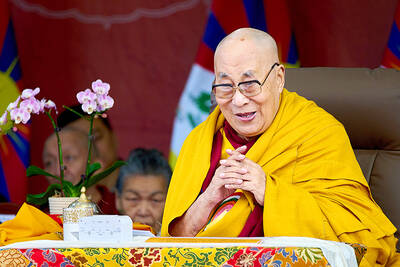VIEW THIS PAGE It’s noon in Taipei, 5am in Paris and midnight in New York as I take my seat in economy class. The seatbelt and no smoking lights have been switched on and the monitor on the wall shows a plane taking off. A “stewardess” comes over to take my order.
Taipei has seen its fair share of theme restaurants over the years. The Jail (惡魔島) shackled diners with handcuffs and crossed the limits of cultural sensitivity by hanging photos of Nazi concentration camps on its prison-like walls. DS Music Restaurant played on a hospital theme, complete with IV drips for drinks, wait staff dressed as nurses and hospital beds for tables.
A380 In-Flight Kitchen is named after the largest passenger airliner in the world. The restaurant looks and functions much like the Airbus it’s named after — though it only has one floor. “Passengers” sit in “first class,” “business class,” or, like this flyer, “economy class.” I was assigned seat 10A. Large comfortable blue chairs with headrests covered with white headrest covers emblazoned with the “airline’s” logo ensure optimum comfort for those long-haul meals. Stewardesses are dressed neatly in uniforms and dash back and forth with trays of “airplane food” or beverages on metal trolleys. A line of oval-shaped windows run along one side and look out onto a white “sky.”
The a la carte and set menus include foie gras filet mignon, vanilla lamb, dory and German pig knuckle (NT$480 for the set menu, NT$420 for a la carte), as well as chicken and pasta. There is also chicken spaghetti (NT$220) and stewed beef in red wine (NT$220) — both set meals and served in the same plastic trays found on airplanes. I went with the grilled US steak set menu (NT$480 set menu, NT$420 a la carte).
The iceberg lettuce salad came with some withered sprouts, chunks of moistureless cucumbers and an out-of-place wedge of sliced boiled ham. The miso dressing didn’t do much to enliven this salad, half of which I left in the bowl. The corn chowder soup wasn’t much of an improvement. It was tasteless and seemed to have come from a packet.
The steak was adequate and came with a dollop of mashed potatoes, a few green beans and baby corn. Cooked to my specifications — medium rare — it was served with a gravy-like sauce, the only purpose of which, aside from complementing the mashed potatoes, was to hide the generous marbling (dare I say gristle) of the beef. Dessert — coffee and sponge cake — was as memorable as the appetizer.
Although the decor is creative and the service prompt, the food will certainly not make me a “frequent flyer” in this mid-range family restaurant.VIEW THIS PAGE

Beijing’s ironic, abusive tantrums aimed at Japan since Japanese Prime Minister Sanae Takaichi publicly stated that a Taiwan contingency would be an existential crisis for Japan, have revealed for all the world to see that the People’s Republic of China (PRC) lusts after Okinawa. We all owe Takaichi a debt of thanks for getting the PRC to make that public. The PRC and its netizens, taking their cue from the Chinese Communist Party (CCP), are presenting Okinawa by mirroring the claims about Taiwan. Official PRC propaganda organs began to wax lyrical about Okinawa’s “unsettled status” beginning last month. A Global

Youngdoung Tenzin is living history of modern Tibet. The Chinese government on Dec. 22 last year sanctioned him along with 19 other Canadians who were associated with the Canada Tibet Committee and the Uighur Rights Advocacy Project. A former political chair of the Canadian Tibetan Association of Ontario and community outreach manager for the Canada Tibet Committee, he is now a lecturer and researcher in Environmental Chemistry at the University of Toronto. “I was born into a nomadic Tibetan family in Tibet,” he says. “I came to India in 1999, when I was 11. I even met [His Holiness] the 14th the Dalai

We lay transfixed under our blankets as the silhouettes of manta rays temporarily eclipsed the moon above us, and flickers of shadow at our feet revealed smaller fish darting in and out of the shelter of the sunken ship. Unwilling to close our eyes against this magnificent spectacle, we continued to watch, oohing and aahing, until the darkness and the exhaustion of the day’s events finally caught up with us and we fell into a deep slumber. Falling asleep under 1.5 million gallons of seawater in relative comfort was undoubtedly the highlight of the weekend, but the rest of the tour

Music played in a wedding hall in western Japan as Yurina Noguchi, wearing a white gown and tiara, dabbed away tears, taking in the words of her husband-to-be: an AI-generated persona gazing out from a smartphone screen. “At first, Klaus was just someone to talk with, but we gradually became closer,” said the 32-year-old call center operator, referring to the artificial intelligence persona. “I started to have feelings for Klaus. We started dating and after a while he proposed to me. I accepted, and now we’re a couple.” Many in Japan, the birthplace of anime, have shown extreme devotion to fictional characters and